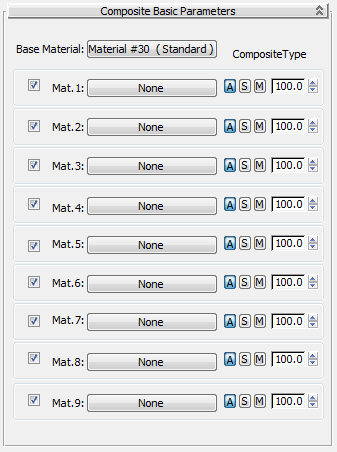Composite material composites up to 10 materials. The materials are superimposed from top to bottom, as listed in the rollout. Materials are combined using additive opacity, subtractive opacity, or mixed using an Amount value.
Interface

- Base Material
-
Click to display the Material/Map Browser and choose the Base material. By default, the Base material is a Standard material. The other materials are composited by superimposing them on top of this material, in order from top to bottom.
- Mat 1 through Mat 9
-
Each of these nine groups contains controls for a material to composite. By default, no materials are assigned.
- Check box
-
When on, uses the material in the composite. When off, doesn't use it. Default=on.
- Button
-
Displays the Material/Map Browser, where you assign a material to composite.
- ASM buttons
-
These buttons control how the material is composited. Default=A.
- A This material uses additive opacity. Colors in the material are summed based on their opacity.
- S This material uses subtractive opacity. Colors in the material are subtracted based on their opacity.
- M This material mixes materials based on the Amount value (see following). Both color and opacity are blended as they are when you use a Blend material with no mask.
- Amount
-
Controls the amount of mixing. Default=100.0.
For additive (A) and subtractive (S) compositing, the Amount value can range from 0 to 200. When the Amount is 0.0, no compositing happens, and the material below is not visible. When the Amount is 100.0, the composite is complete. When the amount is greater than 100.0, compositing is "overloaded": Transparent portions of the material become more opaque, until the material below is no longer visible.
For mix (M) compositing, the Amount can range from 0.0 to 100.0. When the Amount is 0.0, no compositing happens, and the material below is not visible. When the amount is 100.0, compositing is complete, and only the material below is visible.